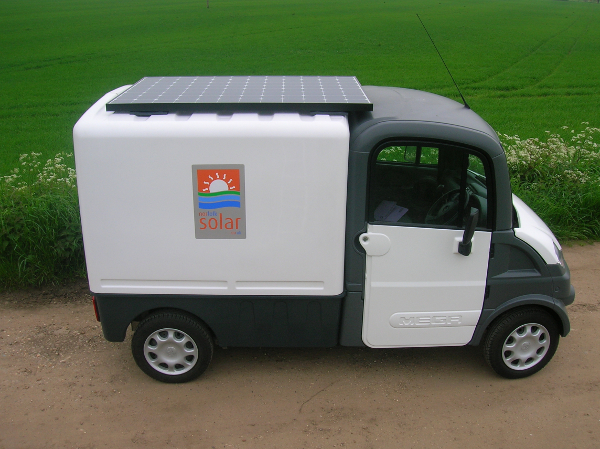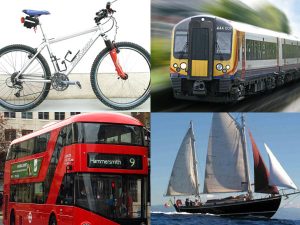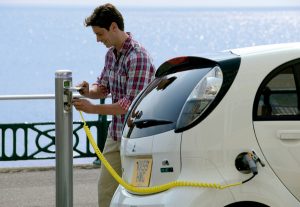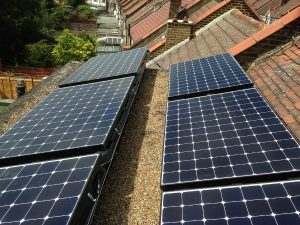Anyone who knows me will tell you I am a person whose private life is smothered by my work. I work in the renewable energy industry – more specifically, I’m a solar energy specialist.I spend most of my working days designing, installing and maintaining solar energy systems and, not surprisingly, I struggle not to think about solar when I’m at home. In fact, I spend quite a lot of time doing solar-related things outside of work. My home is often a series of experiments in how to live by using as little non-renewable energy as possible.
One day, I was surfing YouTube for solar stuff and came across some videos of concept vehicles made by universities around the world to take part in a solar vehicle distance challenge. The ‘cars’ they are using look nothing like road-going cars – long, thin and low to the ground (a bit like a space ship or a top secret stealth plane), very low drag, single seater, lots of pv cells, made from carbon fibre and very expensive plastics.
I started to think ‘why not have a go at making a solar vehicle – maybe a bike, or a car ….. who knows?’ So I made the natural progression from YouTube to eBay and started looking for solar vehicles. Not surprisingly, nobody sells a solar vehicle on eBay, but there are some components on offer.
I spent the next few weeks throwing the idea around and researching, and a plan started to come together. The idea by now is to make a road-going solar electric vehicle – something actually useful day-to-day, that can be used by my company to cut down our transport carbon emissions.
So I started setting out my ‘ideal’ vehicle on paper:
- low weight
- large area for solar cells
- high-density solar generation
- inexpensive (at this stage it’s a concept!)
- 2-seater
- space for carrying goods (it’s a work vehicle)
- usable top speed and range for the likely journeys (urban short trips are looking sensible for a concept vehicle – who knows, it might break down, and then I’ve got to get it back to base!)
- usual road safety features
As I’m not interested in spending a lot of time reinventing a conventional vehicle, I looked around for what I thought was the best road-going donor vehicle. After much trawling of car magazines, used car buying guides, internet sites, conversations with friends who happen to know a lot about cars or work in the automotive industry, I discovered a little French company that makes micro cars and vans – Aixam………Bingo!

The naked Axiam micro-van arrives
Aixam make an electric version of their micro-van: road-going, crash-tested, lightweight, has a pretty big roof, can carry about 300kg / 3 cubic metres, has 2 seats, and uses good old lead-acid AGM batteries (heavier than Lithium but if looked after are very dependable and cheaper). The van is called a MEGA 600E.
Back onto eBay, I bought a second-hand Aixam MEGA van and got it transported from London. I spent the next few weeks getting to know what the van can do in its standard format:
- top speed is around 30mph
- range on a full charge varies: at road speeds (25-30 mph) it can do about 30 miles before the ECO function starts to annoy you (ECO mode automatically engages when the van’s computer measures a low voltage – the idea is to reduce battery damage and get you home). A friend told me some interesting bits of information – apparently, the average UK journey is around 7 miles, and 20% of all journeys less than one mile are in a car! As the van I bought is 4 years old, I checked the range figures against a brand new MEGA electric van owned by a company in the neighbourhood – this suggests the batteries are in good condition.
- handling is fine: parking is a bit heavy as it doesn’t have power steering but that’s a good thing with an electric vehicle as it doesn’t drain the batteries for steering
- braking takes a bit of getting used to: no power assisted brakes means you need to put your foot down harder and anticipate better when driving – lets face it, there was a time when all vehicles were like this, and the limited top speed actually helps here
- suspension: its quite springy, mainly because there’s not a lot of weight to the vehicle. This may be a problem when going over bumps if I put glass covered solar panels on the roof!
- controls: all pretty standard, normal steering wheel, indicators, fan, lights, dashboard instruments…..then there’s the electric drive stuff, battery state of charge indicator, charging icon, low and high speed selector (high seems necessary for roads, low would be great if the van was used on a private estate/airport/university campus and would extend the practical driving range)
- under the bonnet: everything is covered by a plastic tray – so I get that out of the way and find an electric motor, a vast series of unmarked wires, a power converter (this changes battery voltage to charge an auxiliary battery for the headlights etc), a computer that governs the motor & traction batteries and an on-board battery charger (which seems to take about 5-8 hours to charge the traction batteries from mains electricity depending on how far you’ve driven)
Next job: how to add solar power. I have a solar PV system on my house, and I suppose you could say that the van is solar-powered if you simply charged it from that system. That’s fine if the van is at home, but what about at work, or when the van is out and about picking up and delivering goods, or even sitting in a car park? Besides, plugging into a building’s solar PV system isn’t what I had in mind when I was surfing the internet at the start of this project. What’s needed is on-board solar power.
Even though the van has a nice, almost flat roof, the size still limits the amount of solar that can be installed. I don’t want anything hanging over the edges, or in a position that can be ripped off by airflows. So the hunt is on for the best solar cells to fit the roof, and I start by looking into whether I can build my own PV module from individual cells to exactly fit the maximum roof area (I went on a course at Lowimpact.org which showed you how to make your own PV module – any size, any shape). This quickly looks impractical for a number of reasons so I turn to our global database of factory-made PV modules to find the best size and shape module for the job.
As it turns out, my company, Norfolk Solar, is an authorised installer for the world’s highest efficiency solar PV modules, and they make a module which is almost the perfect size, and has the highest energy density and yield of anything available. They’ve used the same cell technology on some of the university-made solar concept cars, a circumnavigating solar-powered catamaran, and a solar-powered aeroplane.
I spent spare minutes over the following few weeks designing the special mountings for the PV module (this is very important as PV modules are rarely designed to be installed on vehicles, and need to withstand the unique shocks and forces acting upon them in this environment), designing the cable connections, display data and switching system, and working out how to route the cables safely around the van.

Lee Rose, solar van maestro
I also started talking to my vehicle insurance company to see if they would permit the newly-modified vehicle on the road – in the end I had to change insurers and jump through a few hoops to make this possible. By June 2012 the vehicle is undergoing off-the-road testing of the on-board solar PV system, and some tweaking is necessary. By the end of June, the vehicle is ready for the road. I charged it for the last time from the mains (actually from the solar PV system at my house) and the ‘solar mileage marathon’ begins!
Its now late September 2012 and I’ve been driving the van around on short urban trips (I’m still a bit nervous about the van conking out for some reason and having to get it recovered – there’s no logic to this as it’s been absolutely faultless!). So far, I’ve driven a total of 250 miles and I haven’t plugged into the mains since the end of June. Using this initial data and plotting projections against 20-year averaged weather data for my area, it looks like I’ll get somewhere between 600 to 1000 on-board SOLAR miles a year.
I’ve noticed from the data display that the solar seems to be keeping the batteries in pretty good condition – it’s doing a great job of equalizing the voltages, and I’m learning more every week about how driving style affects battery power and range. One other thing I’ve noticed – the standard equipment battery state of charge indicator constantly reads ‘almost empty’ which I know is wrong (because of the data display I’ve installed) – I’m going to have to intercept the wiring to this and fix it – it’s not a practical problem as it doesn’t affect the performance in any way, but it’ll annoy me if I leave it!
I’ll probably play with the data display a bit more so it gives more information and I’ve got some ideas of where to take the project next, but in terms of the original plan, it seems many of us could indeed have a practical little urban vehicle powered by the sun!





11 Comments
We are thinking of buying a second hand electric Mega van and just wondered how you have got on with your conversion? We currently own a Nissan Leaf (had it for 3 years) and a Vectrix scooter (about 8 years), together with 2 electric bicycles so are used to electric vehicles. Regards, Elaine.
Can u tell me if your conversion to solar panels on your megavan was a success? what are the pitfalls, if any? And costs? If am close to committing to a electric megavan but batteries are spent. Any ideas on replacements? Thanks
Is is still running and what is the kit you used to convert it – thinking of doing the same to my van
Hi. The van now lives at the offices of our associate company and I last had an update from them in late 2017 to say that they still use it each week for short business trips.
If you want to do the same, I see that vans like this are still available on Ebay, and the Sunpower solar panels are also still available from authorised suppliers. The Sunpower solar panel is an unusually high voltage, so the key is to get a solar charge controller that can accept a maximum 75V DC input and not limit the wattage (many seem to be less than 60V DC and 200 watts).
As far as I know, Ransome’s Jacobsen are now the UK distributor for the replacement to the Aixam Mega Van, and so should be able to supply parts if needed.
Note: when I had the van serviced in 2012 by the then approved UK service mechanic, they reported back to the engineering team at Aixam in France, who sent back a message that it wasn’t possible to wire up the batteries on this vehicle to on-board solar…..they seemed to believe that the van’s computer would not recognise the solar charging and stop the van working. This didn’t happen with my van….I think they were playing safe because nobody at Aixam had tried it. The computer doesn’t see the solar charging and so didn’t register the true traction battery voltage on the instrument panel, but it definitely didn’t stop the van working. This is why I wired up some voltage displays which circumvented the computer to see the true traction battery voltage.
I hope this helps.
Perfect Lee thanks. Could you either give a bit more spec for the kit or offer your unique services to supply and fit?? In Cambridge.
Hi Peter. I don’t offer a supply and fit service and as I no longer own a solar company I don’t have the equipment or insurance to do this kind of work for customers, sorry. The Sunpower solar panel is available from Norfolk Solar but transporting costs are very expensive for glass objects on an oversized pallet. For a megavan solar conversion, the objective is to acquire the most energy dense solar panel you can afford, and using the solar panel’s data sheet, a suitably sized charge controller can be sourced, either from a solar specialist in the UK or on Ebay. The charge controller needs to be able to handle the highest likely voltage, current and wattage from the solar panel without either blowing a component or derating the panel’s output. Other parts needed are cabling, an isolation switch, a voltage display and some mountings for the panel.
I appreciate that I’m simplifying the process here and i did consider making a training pack for converting a van but there are a number of variables and I can only comment on the equipment and vehicle I used; I have no experience of the solar compatibilty of other electric vehicles. Unfortunately, there hasn’t been enough public interest for me to commit the time needed to put such a training pack together.
I have from time to time shared more detailed information on this project informally, but that has only really been when I have had cause to be travelling and spending time with an interested person on other business.
I do still advise and troubleshoot solar energy systems in homes occasionally but rarely travel outside Norfolk for this nowadays and I no longer teach courses throughout the UK, though I do travel as far as the midlands for geobiology assessments.
Good luck with your project….in my experience an electric vehicle is great fun and can be ideal for urban journeys….the possibility of adding onboard solar just makes it more appealing.
I’m always keen to see pictures of projects, the furthest I’ve received to date are from Austria, and Lebanon, both using Aixam vans.
Hi there, I realise this post is like 10y old now but is the van still in action? I’m looking at converting one of these vans into a solar powered campervan. My aim is to travel the country in it stopping to sleep and charge. Would it be possible to view the van if I contacted the people who now own it? I would love to have a chat about it and get your opinion on some ideas I have too. I would meet you wherever is convenient for you. Thanks Lee.
Dear Lee,
I’m so glad I have found your article. You have done what I have been thinking about, bravo.
I’m an owner of a Aixam 600e (2007) mega truck, and have been thinking about its potential to have a solar panel mounted to its roof to assist in charging its onboard batteries (I had new batteries replaced a year ago).
I appreciate that your involvement was a long time ago, however ANY information you could share would be wonderful. (I’m based in North Somerset)
All the best Simon
I can help with advice on solar power system, charger, watt meter and custom LIFEPO4 BATTERY for Aixam, using EVE cells grade A as a back up power to add miles and Ac power to the box van for tiny camervan conversion. I can design a special kit of furniture for the cargo box to fit 2 adults, folding single beds, elevated on cabinets in one side, folding in from the left passenger seat which folds in and out for the single beds extension at night. Plus, kitcken with sink and cooker
It’s been 11 years since the road trials with my solar van and it’s great to see that people still want to do projects like this.
It’s also nice to see that there are people out there who can help others complete their aixam van projects.
The original van is still around, though it’s now owned by Solar Power GB in Braintree (for those that want to ask to view or purchase it, please make direct enquiries with the company).
Since 2012, there have been significant mprovements in battery products, and if I were attempting the project again today, I would certainly be looking to use lithium iron phosphate batteries ……the environmental and economic case is very strong compared to alternatives, and voltage compatibility very good (unlike AGM or lithium ion, which would need more tweaking).
I have since also owned a Reva G Wiz electric car, and I had a close inspection of the drive system and electrics. I didn’t convert this car to solar but I do think it would be another excellent candidate due to its simplicity; however, there is precious little roof space to accommodate a solar panel, and it’s only been very recently possible to acquire very high energy dense (small footprint) PV panels for this purpose. Again, lithium iron phosphate would be a sensible upgrade for this type of car.
I did happen to see that someone on the south coast was selling a solar + lithium iron phosphate upgraded G Wiz in 2021 so congratulations to whoever purchased it!
There are other possible donor vehicles although I haven’t seen these close-up. They include the Goupil G3, the Alke XT320, and more recently a number of Chinese manufactured vehicles that share a body and platform but may have other differences and are sold under different brands. One example would be the Siticars Carryme van.
I believe Go Green in London also sell a newer van called Saturn.
The Aixam is of course much older, and so easier to acquire a used vehicle at a reasonable price. It does also have a very useful size cargo area which lends itself well to solar panels, and a very simple power control system which seems to allow solar contribution directly to its traction battery …..although Aixam’s technical team in France were rather adamant back in 2012 that this was not possible. Indeed they were so curious about it that soon after I got an invitation to display the solar van at the Ransomes Jacobsen factory open day (this company was the new UK distributor for Aixam after its parent company Textron purchased Aixam.
I’m not suggesting you ignore every vehicle manufacturer’s advice, but do please make your own decision on these type of projects. I think the world needs pioneers that are not easily dissuaded.
Good luck everyone.
This is a really interesting article!
Me and my wife own a Aixam Mega 600E and have done since November 2022, we had the batteries replaced back in February 2023 and hey are still going strong, done more than 5000 miles in it! We have lost a small amount of range but we only use it locally so it doesn’t make too much difference, however I came across your article as I was looking at adding a small solar panel to the auxiliary battery, as our fuse box that allows the DC converter to charge the auxiliary battery failed, so everytime it needs charging I have to manualy charge it with a battery charger, bit of a pain sometime as if I’m in a bit of a rush I have to re-connect everything back up, but if there was a solar panel in place to charge it that would save me faffing about!
Anyway, thanks for the interesting read I have shared it to our Aixam Facebook group! for anyone that would like to join I have attached a link here: https://www.facebook.com/groups/2319777354935833
Best of luck to everyone!